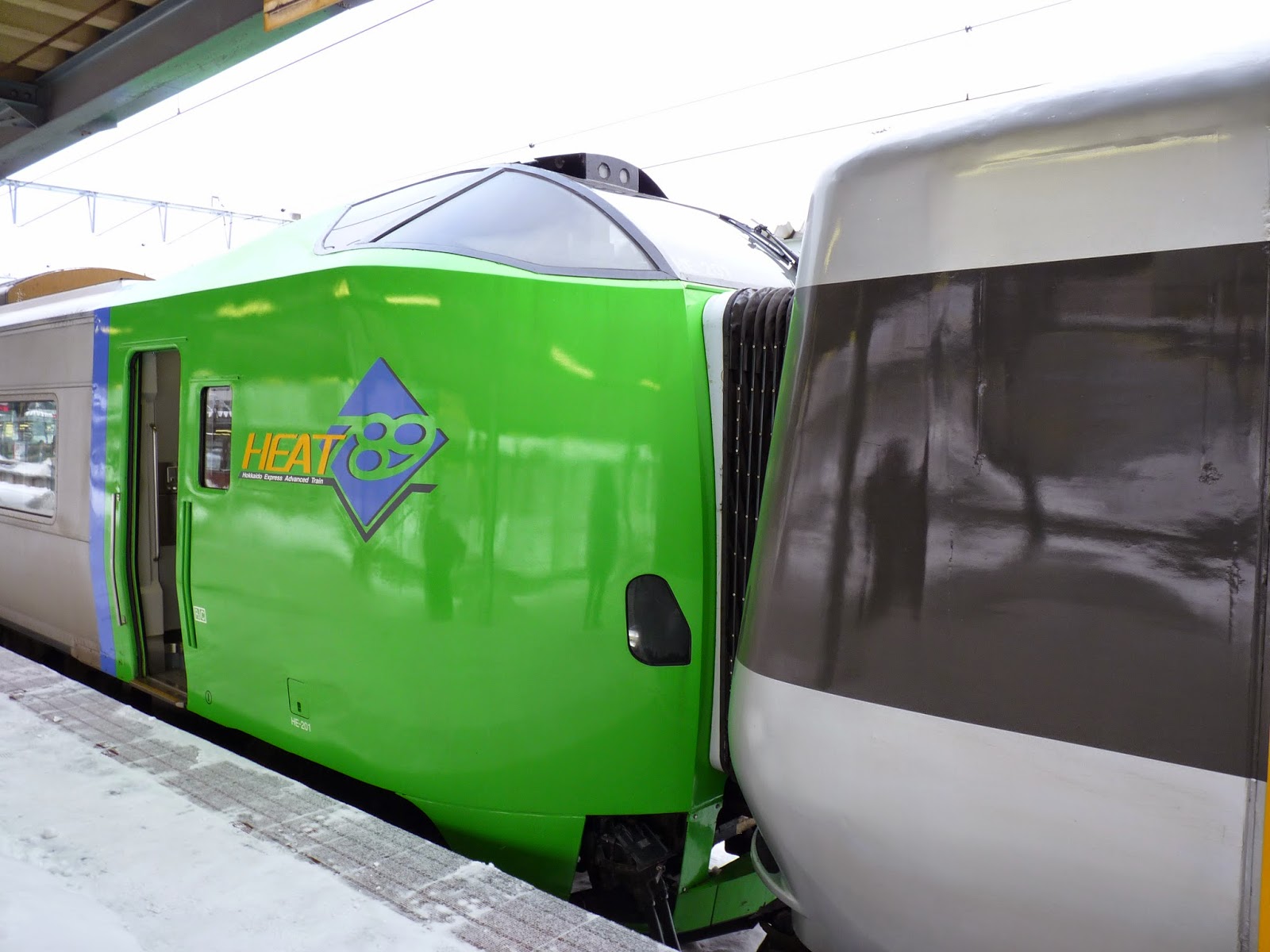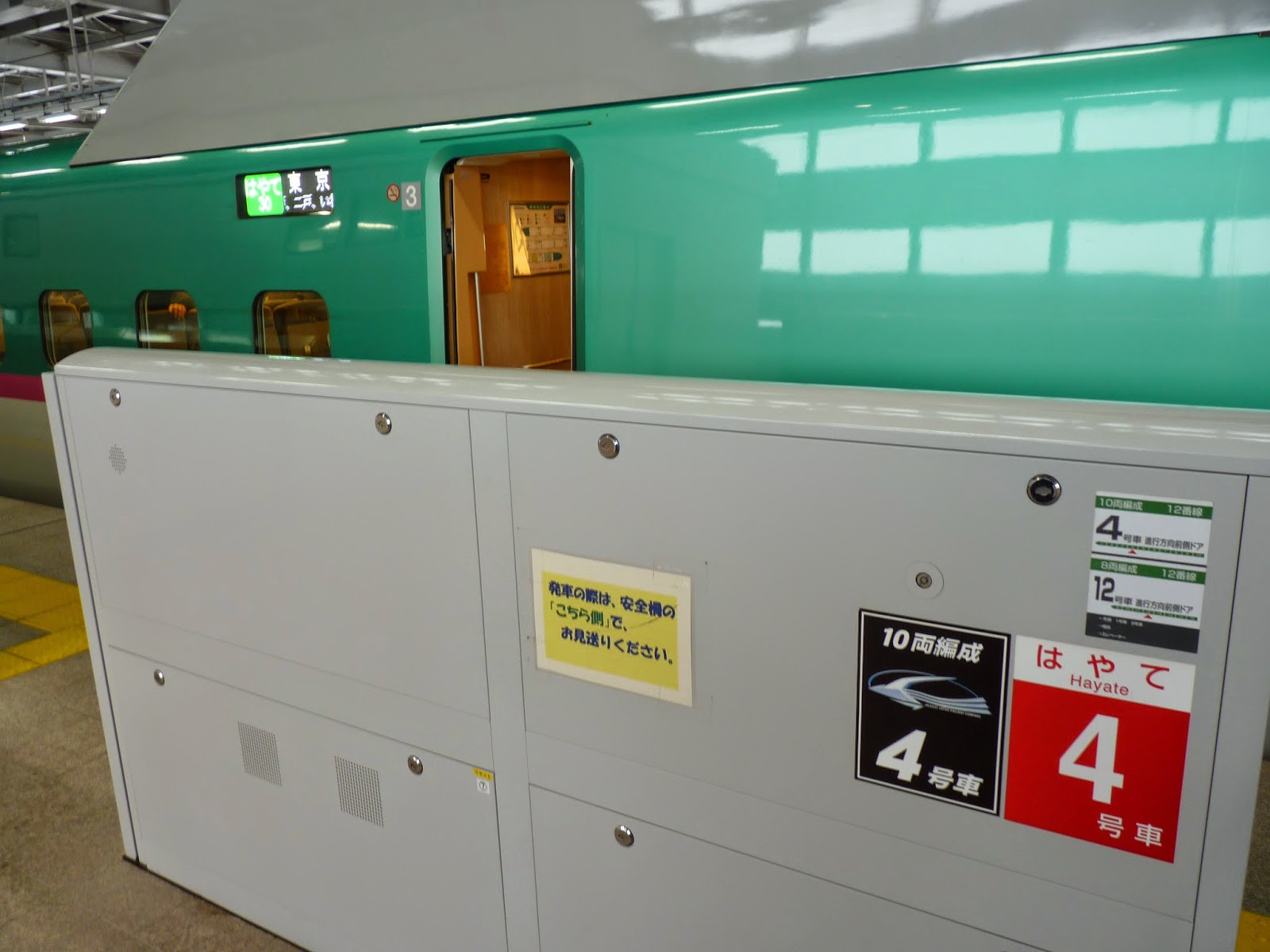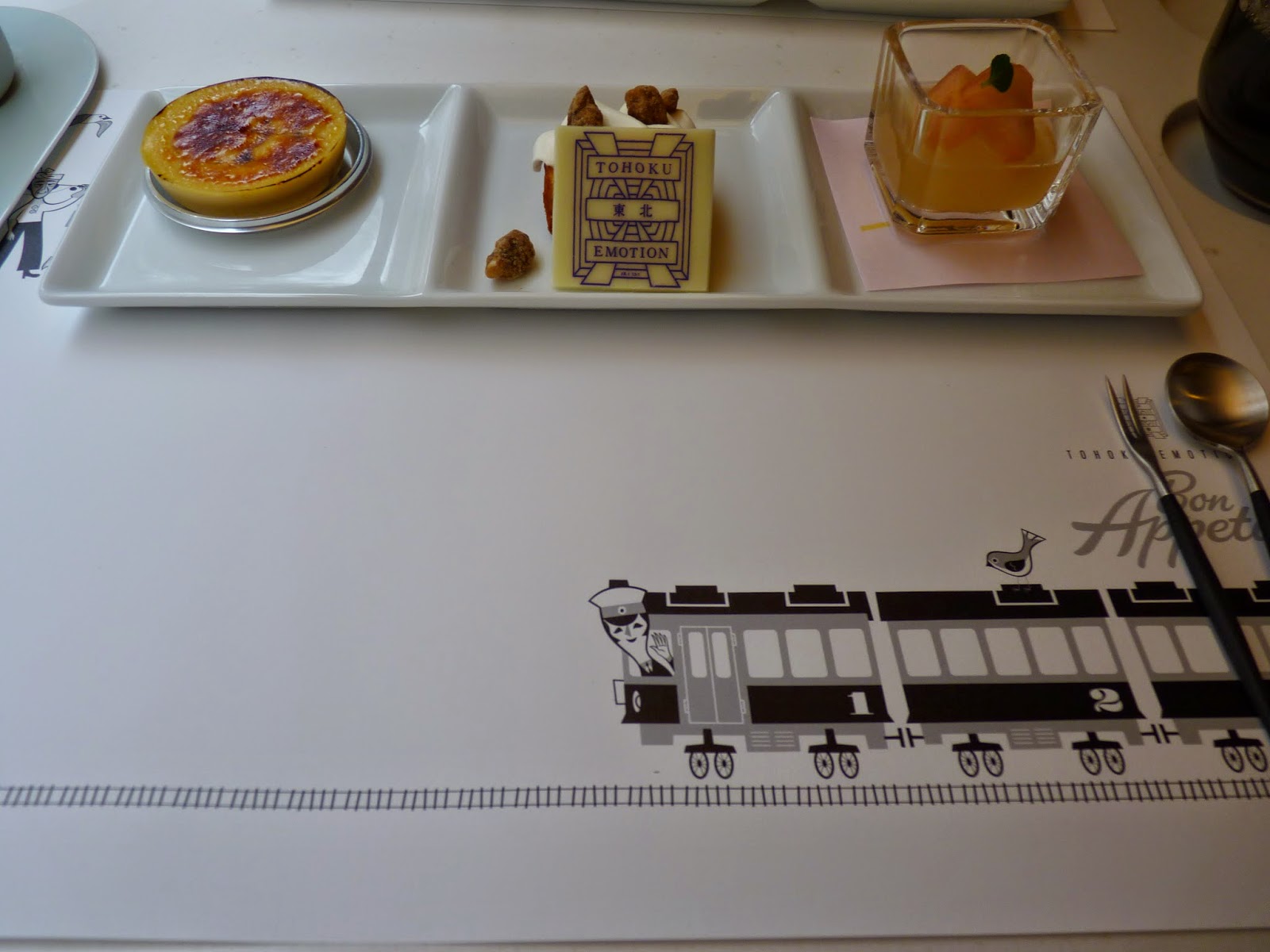The final blog entry for my 2014 Japan trip covers the return leg from Hakodate, Hokkaido, back to Tokyo. We took a detour along the way to experience the Tohoku Emotion train!
Above is the platform at Hakodate Station, with the Super Hakucho electric train ready to take us to Shin-Aomori Station.
Below is a close up of the destination screen on the side of one of the carriages, which switches between English and Japanese:
Moving along the train, you can see the connection between the passenger cars:
This is the front of the Super Hakucho train - as you can see sitting down on the platform while waiting is not an option!
Inside the passenger car on Super Hakucho:
On the back of the fold down meal tray at my seat is a very helpful guide to the timings and length of the Seikan tunnel, which is the longest tunnel in the world at 53kms, linking Hokkaido and the main island of Honshu. Super Hakucho passes through it on the way to Shin-Aomori in Northern Honshu, our final destination:
Interestingly enough there are two underground stations inside the Seikan tunnel (shown above) to allow for escape routes if needed from the Seikan tunnel. These stations were both closed to public use recently to allow work on the Hokkaido Shinkansen line in the tunnel to be completed.
Inside each passenger car is a display which shows the passenger car number, the time, toilet busy/free and also...the current progress of the train on the journey:
Particularly cool in my opinion is the progress display when approaching and entering the Seikan tunnel:
On the other side of the tunnel, we are approaching Shin-Aomori, with plenty of snow still around:
We also saw an overnight blue train Akebono along the way, destined for nearby Aomori Station - the Akebono train has since been permanently stopped and sadly no longer runs:
Here we are stopped at Shin-Aomori station. We only had a few minutes to briskly walk to our next train:
Because of the short transfer time, I could only grab a few snaps of the Hayate Shinkansen we caught at Shin-Aomori, prior to boarding - this is a local Shinkansen that stops at smaller station and larger ones:
The Hayate Shinkansen bold green nose is something else - this is a seriously big nose!
Once inside the Hayate Shinkansen, we could relax - here is some photos inside the passenger car:
From within the train I could get off a few photos of Shin-Aomori station platform:
We didn't travel far on the Hayate Shinkansen. We had decided to take a detour on our way back to Tokyo. We got off at Hachinohe Station so we could experience the Tohoku Emotion train. We were very lucky, and only got onto this train because of a last minute cancellation! It is hard to get tickets for this train so we were very glad to get them!
Here is the JR Hachinohe and Aoimori Line entrance from the Shinkansen platform:
Here is the Tohoku Emotion train on the platform at Hachinohe:
So what is the deal about this particular train? Well, after the Tsunami and Earthquake in Japan back in March 2011, many parts of Tohoku region were devastated by the Tsunami, with entire towns wiped out and many lives sadly lost.
This train was built for a short run only to help fund reconstruction efforts for destroyed JR lines in the Tohoku region, by showcasing the best of Tohoku sourced food, chefs and staff to take passengers on an emotional journey to show the best of Tohoku, the effects of the tsunami, and the ongoing reconstruction that has already been done in the region. That reconstruction includes the line that this train runs on, which had to be mostly rebuilt after the Tsunami.
The train itself travels to Kuji Station, deep in the heart of Tohoku region on the coast, and the town was featured in the very popular NHK drama Amachan in 2013.
Once seated on the train in our exclusive compartment, we had a beautiful setup on the table in front of us - the placemat was beautifully detailed and made in Tohoku, but regrettably not for sale (we checked!):
The view from our compartment, prior to departure from Hachinohe Station:
You can see the compartment is beautifully built, with some nice details on the walls and doors - including a two way opening for delivering food to, to avoid disturbing the passengers during the experience:
Views down the passenger car from outside the compartment:
View from just outside the Drivers cab:
View of the kitchen, where the chefs are already at work preparing our meals:
This is the Menu in Japanese only. As this is like a degustation style meal, it is mainly for information about what food you will be served, since you don't actually choose anything:
Our first course of many arrived:
Outside the window is the view along the Tohoku coastline near Hachinohe:
As each course comes out, some of the background about the source of the food in Tohoku is explained by the waiter:
The Aomori Cider was very good:
More courses follow, and each one was delicious:
The views from the train get more and more beautiful - you start to understand why people want to live in the Tohoku region:
In the Amachan drama, they invented a phrase of exclamation "Je Je", which someone has inscribed into the snow to see from the train as we passed:
As we continued along the coastline I could make out some people waving and cheering to us as we passed:
On board the train, they explained that the people of Tohoku were so grateful for the support of the Japanese people in the reconstruction efforts, and this was a small display of that gratitude:
Needlessly to say, it was quite emotional moment, with memories of the Tsunami coming flooding back, and myself and my wife tearing up at this point. I guess they don't call this train Tohoku Emotion for nothing.
They provided a book that showed some of the more beautiful parts of Tohoku, now washed away and destroyed by the Tsunami:
And also curiously, a lollipop.
As the food service continued into Dessert, the boxes that contained them got more and more elaborate and beautiful:
After this we had some free time so I wandered the train to look around:
Here is the driver at work on the Tohoku Emotion train, showing some of the scenery passed through on the way to the small seaside town of Kuji:
Finally, we arrived into Kuji Station:
The Kuji Station platform signs:
At the time of being there the line south of Kuji Station was not running as the line itself was still being reconstructed by JR following the tsunami. Since then a lot of the line south has now been reconstructed.
Here is the Tohoku Emotion train at Kuji Station:
We were given about an hour to look around the Kuji township before returning to Hachinohe - we got a nice welcome on our arrival into Kuji:
Another view of the Tohoku Emotion train on the platform at Kuji Station:
Outside of JR Kuji Station:
Next to JR Kuji Station is the private operator Kuji station (used for the South bound lines), which was heavily used for filming the NHK drama Amachan.
Down the road from the station is a roadhouse containing the Matsuri (Festival) float used in summer in Kuji - it also has plenty of references and pictures of the actors from the Amachan drama - this drama was VERY popular in Japan - and lots of people have come to visit Kuji since then to see the filming locations - it is a very local town:
Having finished our look around Kuji, we came back onboard the Tohoku Emotion for the return trip to Hachinohe.
In our compartment we found a new placemat, ready for the desserts that would be served on the way back!
We even got a Bon Voyage send off from the station as we left:
The desserts were delicious of course!
We also received some postcards and a pen en-route back to Hachinohe:
Now back at Hachinohe Station, I had a bit more time to take some photos of the train and surrounds:
View of the platforms at JR Hachinohe Station (with Tohoku Emotion visible on the right):
Tohoku Emotion promos are all of the station concourse:
I was very glad to take the side trip on the Tohoku Emotion.
We then entered the Shinkansen platforms at Hachinohe and awaited the arrival of our final train, the Hayabusa Shinkansen that would take us back to Tokyo.
Here is the view of the Shinkansen platforms are Hachinohe:
The waiting room had some interesting wooden furniture in it. It was very cold outside, so everyone waited in the waiting room to keep warm!
Platform side now, with our Hayabusa Shinkansen train due shortly:
Hachinohe Platform signage:
The Hayabusa Shinkansen then arrives into the station:
For this last leg, we decided to go all out and book a Gran Class seat. This type of seat (at the time) was only available on this train, with one carriage allocated exclusively for Gran Class passengers:
Here is the Gran Class seat - like a business class aircraft seat it can recline multiple ways for comfort:
Gran Class includes all food and drink, with plenty to choose from:
View of the Gran Class carriage as we arrived into Tokyo Station:
At Tokyo Station, i quickly jumped out to run down the train for "that shot":
The Hayabusa connects with the Akita Shinkansen en-route to Tokyo, forming a very long train. The interesting noses on the front and rear of the newer model shinkansen makes for a very interesting connection between them. I also managed a shot showing a different model Shinkansen in the background arriving at another platform - three shinkansen trains in one photo :-)
I took some photos on the Tokyo Station platform to finish off:
I hope you have enjoyed these blog posts on my Japan trip in 2014 - I tried to squeeze as many different train journeys as possible into a two week timeframe using the JR Japan Rail Pass, and certainly had a fantastic time exploring Japan.
I will be travelling on more Australian trains for New Years this year, so look out for more blog posts in early 2015! In the meantime have a greta New Year everyone!




























































































